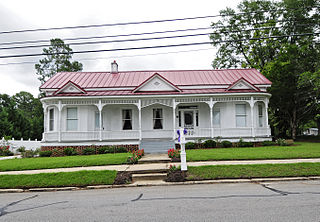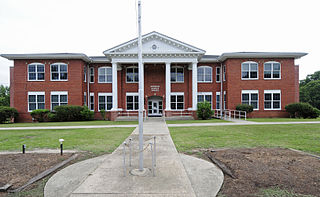
Lexington is the most populous town in and the county seat of Lexington County, South Carolina, United States. It is a suburb of the state capital, Columbia. The population was 23,568 at the 2020 Census, and it is the second-most populous municipality in the greater Columbia area. The 2022 estimated population is 24,626. According to the Central Midlands Council of Governments, the greater Lexington area had an estimated population of 111,549 in 2020 and is considered the fastest-growing area in the Midlands. Lexington's town limits are bordered to the east by the city of West Columbia.

Batesburg-Leesville is a town located in Lexington and Saluda counties, South Carolina, United States. The town's population was 5,362 as of the 2010 census and an estimated 5,415 in 2019.

Simon Bouknight House is a historic home located at Batesburg-Leesville, Lexington County, South Carolina. It was built in 1890, and is a one-story, weatherboarded Victorian cottage under a gabled roof. It has a gabled projecting central porch supported by four regularly spaced slender wood posts; front and end gables with cornice returns and centered, diamond-shaped windows; and corbeled chimneys. The house is set on a lattice brick foundation.

Cartledge House is a historic home located at Batesburg-Leesville, Lexington County, South Carolina. It was built about 1898, and is a two-story, Victorian-era weatherboard dwelling. It consists of a rectangular central block under a hipped roof with sheet metal shingles and a truncated ridge. Double gallery porches wrap around the front and side elevations on both stories ornamented by Tuscan order colonettes and turned balustrades. The front roof slope features a steep cross gable pierced by a circular vent.

Broadus Edwards House, also known as the Paul Garber House, is a historic home located at Batesburg-Leesville, Lexington County, South Carolina. It was built in 1905, and is a 1+1⁄2-story, Queen Anne style weatherboard residence set on a brick foundation. It has a two-story turret under a tent roof and a bay surmounted by a pedimented cross gable. The house was built by Broadus Edwards, prominent Batesburg merchant, mortician, and town councilman.
Hampton Hendrix Office is a historic home office building located at Batesburg-Leesville, Lexington County, South Carolina. It was built about 1897, and is a one-story, decorated Victorian rectangular weatherboard building. It measures approximately 3 metres by 5.49 metres, and has a gabled metal roof and highly decorative façade. The building is set on a lattice brick curtain wall.

Hartley House, also known as the Bond-Bates-Hartley House, is a historic home located at Batesburg-Leesville, Lexington County, South Carolina. It was built before 1800 and is a 2+1⁄2-story, weatherboard dwelling with a two-story portico adapted from the Greek Revival. It has a closed brick foundation and a gable roof. The portico is supported by two square wooden pillars set outside a pair of smaller pillars. According to local tradition, the house served as a stagecoach stop and post office before the founding of Batesburg.

Thomas Galbraith Herbert House, also known as the Shealy House, is a historic home located at Batesburg-Leesville, Lexington County, South Carolina. It was built in 1878, and is a 1 1/2-half story Victorian Eclectic style dwelling. It is sheathed in weatherboard and has a raised seam, metal, multi-gabled roof. It features a projecting front gable with a recessed balcony and a full width front porch.

A. C. Jones House is a historic home located at Batesburg-Leesville, Lexington County, South Carolina. It was built in 1904, and is a California bungalow form influenced weatherboard residence. The hipped roof has three large, hipped dormers. The dormers, roof, and projecting wraparound porch have exposed rafters. The house and porch sit on a granite foundation.

McKendree Mitchell House is a historic home located at Batesburg-Leesville, Lexington County, South Carolina. It was built in 1873, and is a 1+1⁄2-story, Greek Revival style cottage on a brick foundation. It is sheathed in weatherboard and features a projecting central gabled portico.

Mitchell-Shealy House, also known as the Berley Shealy House, is a historic home located at Batesburg-Leesville, Lexington County, South Carolina. It was built about 1855, and is a two-story weatherboard residence that combines Greek Revival and Italianate features. It consists of a rectangular central block and one-story, centered rear ell. It features a central projecting double portico beneath a front gable.

John Jacob Rawl House is a historic home located at Batesburg-Leesville, Lexington County, South Carolina. It was built about 1900, and is a one-story frame Victorian dwelling with elaborate carpenter's ornamentation. It has a brick pier foundation and a standing seam metal gable roof. The façade features a porch with rounded corners and an elaborate spindle frieze.

Old Batesburg Grade School, also known as Batesburg Elementary School, is a historic elementary school building located at Batesburg-Leesville, Lexington County, South Carolina. It was built about 1912, and is a two-story, brick Neo-Classical school building with a central tetrastyle portico and flanking pavilions. The central portico has four colossal Tuscan order columns. An auditorium is located at the rear of the building. Wing additions were added about 1945. It was the town's first public school, housing grades 1–11.

Southern Railway Depot, also known as the Batesburg Boy Scout Hut, is a historic train station located at Batesburg-Leesville, Lexington County, South Carolina. It was built about 1900 by the Southern Railway, and is a one-story weatherboarded frame building with a bellcast hip roof. It has patterned metal shingle roofing and sawn wooden brackets supporting the deep eaves. It was relocated from its original location to its present site about 1960 and used as a meeting place for local Boy Scouts.

Bank of Western Carolina, also known as Lexington State Bank, is a historic bank building located at Lexington, Lexington County, South Carolina. It was built about 1912, and is a one-story, rectangular, brick building. It has a tiled hipped roof and features eave brackets and an arched entry. It is one of five commercial buildings that survived the 1916 fire. The building houses Bodhi Thai, a "fine dining" Thai restaurant.

Old Batesburg-Leesville High School, also known as Batesburg-Leesville Middle School, was a historic high school building located in Batesburg-Leesville, Lexington County, South Carolina. It was built in 1921, and is a two-story, red brick school building on a raised basement in the Tudor Gothic Revival style. It features a low parapet roof banded in concrete, flanking pavilions, and a Tudor arched entranceway.

Home National Bank is a historic bank building located near Lexington, Lexington County, South Carolina. It was built in 1912, and is a two-story brick building. Its corner entrance features a pediment supported by engaged Doric order columns. It is one of five commercial buildings that survived the 1916 fire. The building housed the town's post office from 1912 until the 1960s.

Church Street Historic District is a national historic district located at Batesburg-Leesville, Lexington County, South Carolina. It encompasses nine contributing buildings in a residential section of Leesville. They were largely constructed between about 1865 and 1909, with one house built after 1910. The district includes the Gothic Revival style Leesville Methodist Church (1909) and notable Italianate and Queen Anne style residences.

Leesville College Historic District is a national historic district located at Batesburg-Leesville, Lexington County, South Carolina. It encompasses 28 contributing buildings associated with the Busbee Brothers’ School and the Leesville English and Classical Institute. The district includes institutional and residential buildings in a range of vernacular Victorian architectural styles.

Cedar Grove Lutheran Church is a historic Lutheran Church located at Batesburg-Leesville, Lexington County, South Carolina. It was designed by architect Louis H. Asbury built in 1926–1927. It is a Late Gothic Revival style brick building. It features a crenelated belfry topped by a multi-faceted metal shingle-clad spire.






















